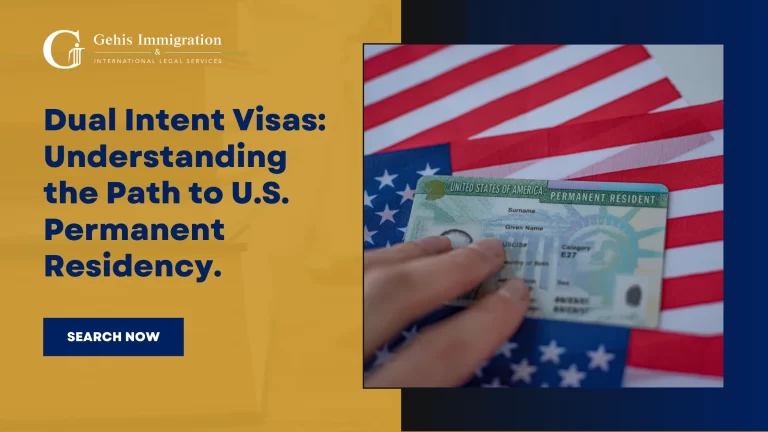Dual Intent Visas: Understanding the Path to U.S. Permanent Residency
The U.S. immigration system offers various visa categories, each serving distinct purposes, from temporary work to study and tourism. One unique aspect of this system is the concept of “dual intent” visas. Unlike most non-immigrant visas, which require applicants to prove they intend to leave the U.S. after their authorized stay, dual intent visas allow individuals to hold temporary non-immigrant status and simultaneously pursue U.S. permanent residency.
This dual intent doctrine is significant in U.S. immigration law because it bridges the gap between temporary employment and permanent settlement in the U.S. For many foreign nationals, it provides the flexibility to live and work in the U.S. while applying for a green card without the risk of jeopardizing their temporary visa status.
The main benefit of dual intent visas is that they enable visa holders to have a clearer and more secure path toward obtaining U.S. permanent residency. This flexibility is especially valuable for professionals and families who wish to settle in the U.S. while maintaining lawful status as they transition to permanent residency.
What Are Dual Intent Visas?
Dual intent refers to a unique concept in U.S. immigration law that allows foreign nationals to legally hold the intention to stay temporarily in the U.S. while also pursuing permanent residency (i.e., a green card). Unlike most non-immigrant visas, which typically require applicants to demonstrate that they plan to return to their home country after their visa expires, dual intent visas permit individuals to maintain lawful non-immigrant status while simultaneously working towards becoming permanent residents.
Dual intent visas give non-immigrants the flexibility to live and work in the U.S. temporarily, under a visa such as H-1B or L-1, while concurrently applying for a green card. This means that dual-intent visa holders can start their immigration journey to eventually secure permanent residency without facing the risk of visa denial based on their desire to remain in the U.S. long-term.
By allowing visa holders to balance temporary and permanent intentions, dual intent visas streamline the immigration process, providing a safer and more predictable route to U.S. permanent residency.
Types of Dual Intent Visas
Several visa categories in U.S. immigration law permit dual intent, meaning that non-immigrants can live and work in the U.S. temporarily while pursuing permanent residency. Below are the most common types of dual intent visas, along with their requirements, eligibility, and the role dual intent plays in the immigration journey.
H-1B Visa (Specialty Occupations)
The H-1B visa is designed for foreign workers in specialty occupations, typically requiring a bachelor’s degree or higher in fields such as IT, engineering, medicine, and finance.
Requirements and Eligibility:
The position must require specialized knowledge, and the applicant must hold at least a bachelor’s degree or equivalent experience in the field.
An employer must sponsor the applicant by filing a petition with the U.S. Citizenship and Immigration Services (USCIS).
Dual Intent Aspect:
H-1B visa holders can pursue permanent residency through an employment-based green card without violating their non-immigrant status. The visa allows them to stay in the U.S. while their green card application is pending.
L-1 Visa (Intra-Company Transferees)
The L-1 visa is for employees of multinational companies who are being transferred to a U.S. office to work as executives, managers, or in positions requiring specialized knowledge.
Pathway to Permanent Residency:
L-1A (for executives and managers) and L-1B (for specialized knowledge workers) visa holders can apply for a green card, often through the EB-1 or EB-2 categories, which offer faster processing times due to their high skill levels and leadership roles.
Dual Intent Mechanism:
L-1 visa holders are permitted to work temporarily in the U.S. while simultaneously applying for permanent residency, without the need to demonstrate that they intend to return to their home country.
O-1 Visa (Extraordinary Ability)
The O-1 visa is granted to individuals with extraordinary ability in fields such as arts, sciences, education, business, or athletics. It is often used by artists, athletes, and other professionals who have achieved significant recognition.
Exceptional Individuals and Dual Intent:
While the O-1 visa is classified as a non-immigrant visa, it allows individuals to maintain dual intent. O-1 visa holders can work in the U.S. temporarily while pursuing a green card, often under the EB-1 visa category, which is for those with extraordinary abilities.
E Visa (Certain Treaty Traders/Investors)
The E visa category is available to nationals of certain treaty countries who are coming to the U.S. to engage in substantial trade (E-1) or invest a significant amount of capital in a U.S. business (E-2).
Specifics of the E Visa Categories:
E-visa holders are allowed to run their businesses in the U.S. while also pursuing permanent residency through employment-based green cards, depending on their level of investment and job creation.
Not all visa categories in the U.S. allow dual intent. For instance, F-1 visas for students and J-1 visas for exchange visitors are classified as strictly non-immigrant visas. These visa holders must demonstrate that they have no intention of immigrating to the U.S. permanently when applying for their visas. Failure to show sufficient ties to their home country can result in visa denial. They may face complications if they later try to adjust their status to permanent residency while still on these visas.
Legal Framework: The Doctrine of Dual Intent
The doctrine of dual intent is an important aspect of U.S. immigration law that allows foreign nationals to temporarily reside in the United States while simultaneously pursuing permanent residency. This concept is embedded in U.S. law and distinguishes certain visa categories from others that strictly require proof of non immigrant intent.
U.S. Immigration Law and Dual Intent
The foundation of the dual intent doctrine is found in the provisions of U.S. immigration law. Most non immigrant visas require applicants to demonstrate an intent to return to their home country after their authorized stay in the U.S. However, dual intent visas, such as the H-1B, L-1, and O-1, provide an exception to this rule. Individuals holding dual intent visas are allowed to simultaneously maintain temporary non immigrant status and take steps toward becoming permanent residents without the risk of visa denial based on their future immigration plans.
The Legal Significance of the Immigration and Nationality Act (INA)
The Immigration and Nationality Act (INA) serves as the legal backbone of U.S. immigration law, and it plays a crucial role in supporting dual intent visas. The INA distinguishes between immigrant and non immigrant visas and outlines the specific conditions under which dual intent is permissible.
For instance, under INA 214(b), most non immigrant visa applicants must prove that they do not intend to abandon their residence abroad, ensuring that they are not seeking to immigrate permanently to the U.S. at the time of visa application. However, the INA makes exceptions for certain visa categories, like H-1B and L-1, that allow applicants to pursue permanent residency while holding temporary visa status. These exceptions provide dual-intent visa holders with legal security, as their green card applications will not affect their temporary status.
The INA’s flexibility regarding dual intent is critical for many foreign professionals, executives, and skilled workers, enabling them to contribute to the U.S. economy while planning for a future as permanent residents.
Challenges in Proving Non Immigrant Intent for Other Visa Categories
For many non-dual intent visa categories, proving non immigrant intent can be one of the most challenging aspects of the visa application process. Individuals applying for F-1 (student), J-1 (exchange visitor), or B-1/B-2 (tourist/business) visas, for example, must provide evidence that they have strong ties to their home country and that they do not intend to immigrate to the U.S.
The primary challenge for applicants in these categories is the need to convince the U.S. consular officer that their stay in the U.S. will be temporary. This often involves providing documentation such as proof of employment, family relationships, property ownership, or other commitments that tie them to their home country. Failure to present convincing evidence can result in visa denial under INA 214(b), which requires consular officers to refuse visas to applicants who are suspected of intending to remain in the U.S. permanently.
This requirement can create obstacles for students, temporary workers, and visitors who might later develop a desire to stay in the U.S. permanently but are constrained by the strict rules against dual intent in their visa categories. The doctrine of dual intent alleviates these difficulties for visa holders in categories that permit it, offering a smoother transition to permanent residency.
The Role of Dual Intent in U.S. Permanent Residency
Dual intent plays a vital role in facilitating the transition from temporary non-immigrant status to permanent residency (i.e., obtaining a green card) in the United States. This doctrine allows foreign nationals to begin the green card process without jeopardizing their temporary visa status, thereby offering a smoother and more secure path to U.S. permanent residency.
How Dual Intent Facilitates the Transition from Temporary Work Status to Permanent Residency
Dual intent simplifies the immigration journey for individuals on certain non-immigrant visas (like H-1B, L-1, O-1) who aspire to eventually settle in the U.S. permanently. The concept allows these visa holders to work or reside in the U.S. on a temporary basis while applying for a green card, either through employer sponsorship, family-based sponsorship, or self-petition (in the case of extraordinary ability categories like EB-1).
Without the dual intent doctrine, non-immigrants would face the challenge of proving that they intend to return to their home country upon visa expiration, even while simultaneously taking steps to gain permanent residency. The dual intent provision removes this contradiction, enabling them to maintain their temporary status and seamlessly transition to permanent residency without the need to return to their home country during the process.
Overview of the Green Card Process for Dual Intent Visa Holders
Dual intent visa holders generally follow one of two main routes to obtain a green card: Adjustment of Status or Consular Processing.
Adjustment of Status (AOS):
This process allows dual intent visa holders to change their status from a non-immigrant to a permanent resident while remaining in the U.S. Once USCIS approves the individual’s immigrant petition (such as the I-140 for employment-based visas or the I-130 for family-based visas), they can file Form I-485, the Application to Register Permanent Residence or Adjust Status. If the application is approved, they will receive a green card without needing to leave the country.
Many individuals prefer adjustment of status because it lets them avoid returning to their home country for visa processing, maintaining continuous residence in the U.S.
Consular Processing:
Dual-intent visa holders may choose consular processing to complete their green card application at a U.S. consulate abroad.
Consular processing requires applicants to leave the U.S. for an interview abroad, potentially disrupting their lives.
Key Advantages for US Visa Holders in Planning US Permanent Residency Path
Dual intent provides several critical advantages that allow visa holders to strategically plan for their future in the U.S. Some of these benefits include:
Security of Status: Dual intent visa holders can remain in the U.S. legally while pursuing permanent residency, reducing the risk of visa denial due to suspicions of immigrant intent during the temporary stay.
Flexibility in Timing: Dual intent visas allow holders to pursue permanent residency at their own pace, without the fear of being forced to leave the U.S. during the process. They can continue working and living in the U.S. while their green card application is processed.
Job Portability: For some visa holders, dual intent facilitates smoother job transitions. H-1B workers can switch employers without jeopardizing their green card process if the new employer sponsors them.
Family Benefits: Dual intent visas often permit dependents to stay in the U.S., keeping families together during the transition.
Reduced Stress in Travel: Dual intent visa holders can travel abroad with less worry, as re-entry denial is unlikely.
Potential Challenges and Pitfalls
Dual intent visas provide benefits for U.S. permanent residency but also pose challenges; understanding them is crucial to avoid disruptions. Below are some of the common challenges faced by dual intent visa holders and tips for overcoming them.
US Visa Renewals While Pursuing Permanent Residency
Dual-intent visa holders often face the issue of renewing their temporary visas while their green card application is pending. Although dual intent allows for a smoother path toward permanent residency, visa renewals can still be a complicated process.
Challenges in Renewals:
Renewing or extending a dual intent visa while pursuing a green card can sometimes lead to confusion at U.S. consulates or during interviews. Consular officers might question the applicant’s true intent, particularly if the green card process is well underway.
Applicants may face scrutiny when renewing their visas abroad, especially if the green card petition (such as an I-140 or I-130) has already been filed, even though dual intent legally permits pursuing permanent residency.
Mitigation Strategies:
Applicants should have documentation that outlines their dual intent status, including employer letters and pending or approved applications, to show compliance with immigration laws.
Remind consular officers of the dual intent doctrine’s legal basis under the Immigration and Nationality Act (INA) when concerns arise during renewal applications.
Common Issues Dual Intent Visa Holders Face
While dual intent lowers the risk of losing visa status during the permanent residency process, visa holders still need to address potential issues, including:
Travel During Pending Green Card Applications:
Traveling internationally while a green card application is pending can pose challenges. If an applicant leaves the U.S. while their Form I-485 adjustment of status application is pending without advance parole, USCIS may deem the green card application abandoned.
Consular processing offers users more travel flexibility, but they should be ready to address questions about their intentions when re-entering the U.S.
Maintaining Status:
Dual-intent visa holders must continue to meet the requirements of their non-immigrant visas. For instance, H-1B workers must maintain employment with their sponsoring employer, and L-1 holders must stay employed with their multinational company.
Failing to maintain status while awaiting green card approval can result in a lapse of lawful presence, complicating the adjustment of status process.
Pitfalls During Visa Transitions:
Some visa holders experience issues when transitioning between visa categories while simultaneously pursuing a green card. For instance, switching from an H-1B to a non-dual intent visa (like F-1 or B-1/B-2) can jeopardize lawful status during the residency application process.
How to Avoid Dual Intent Misconceptions During US Visa Applications.
Misunderstandings about dual intent can complicate visa applications or interviews, especially with consular officers who may be unfamiliar with the doctrine or interpret it too narrowly.
Clarifying Intent During Interviews:
Applicants should be ready to explain dual intent during visa interviews, showing their understanding of the difference between temporary status and long-term permanent residency goals.
Detailing steps toward permanent residency, like working for a sponsoring employer while meeting current visa requirements, can clarify any misunderstandings.
Documentation:
Keep supporting documents—like employer letters, attorney briefs, and relevant petitions—up-to-date to help consular officers and USCIS understand your dual intent status.
Consulting Immigration Attorneys:
Given the complexities surrounding dual intent, especially when dealing with renewals, travel, or changes in visa status, consulting an immigration attorney can help avoid pitfalls and ensure compliance with both non immigrant and immigrant requirements. Immigration attorneys offer guidance on application timing, travel permissions, and specific case nuances.
Final Word
The dual intent visa process and transitioning to U.S. permanent residency can be complex and challenging. Whether you’re an H-1B worker, L-1 executive, or O-1 individual of extraordinary ability, a knowledgeable legal team can make a significant difference.
At Gehi’s Immigration and International Legal Services, we specialize in helping individuals like you smoothly transition from temporary visa status to U.S. permanent residency. Our experienced immigration attorneys understand the intricacies of dual intent visas and will guide you through every step of the process, from maintaining your visa status to ensuring a successful green card application.
Contact us today to schedule a consultation. Let us assist you in obtaining U.S. permanent residency and make your immigration journey as smooth as possible.
Don’t manage this process alone—reach out to Gehi’s Immigration and International Legal Services for legal advice and representation. Start your path to U.S. permanent residency with confidence!






